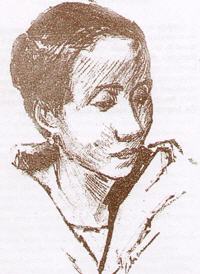- Gregoria de Jesus
Infobox Person
name = Gregoria de Jesus

image_size = 150px
caption = Portrait of Gregoria de Jesus
birth_date = birth date|1875|5|15|df=y
birth_place =Caloocan ,Philippines
death_date = death date and age|1943|3|15|1875|5|15|df=y
death_place =Manila ,Philippines
spouse =Andrés Bonifacio (1893 – 1897)Julio Nakpil (1898 – 1943)Gregoria de Jesus (
15 May ,1875 –15 March ,1943 ), also known as Aling Oriang,cite web | url =http://www.salidumay.org/corner/articles/c2000_0922_01.htm | title =Excerpt cite book |last=Santiago |first=Lilia Quindoza |title=Tales of Courage & Compassion: Stories of Women in the Philippine Revolution |year=1997 |publisher=HASIK inc. | accessdate =2006-12-28] was the founder andvice-president of the women's chapter of theKatipunan of thePhilippines .cite web | url =http://cpcabrisbane.org/Kasama/1996/V10n2/Herstory.htm |author =Jesus, Gregoria de | title ="Filipino Women" | accessdate =2006-12-28 | publisher =Solidarity Philippines Australia Network] She was also the custodian of the documents and seal of the Katipunan. She marriedAndrés Bonifacio , the supremo of the Katipunan, and played a major role in thePhilippine Revolution . She is regarded as "The Mother of the Philippine Revolution" by Filipinos. She has one son fromAndrés Bonifacio and five children from Julio Nakpil.Early life
Gregoria de Jesus was born in the city of Caloocan, in the Filipino province of
Rizal to aCatholic middle-class family .cite web | url =http://www.filipinaslibrary.org.ph/filipiniana/heroes/ |author =Jesus, Gregoria de | title ="The Katipunera" (autobiography) | accessdate =2006-12-28 | publisher =Filipinas Heritage Library] Her father, Nicolas de Jesus, was acarpenter who later served as agobernadorcillo . As a young girl, she was an exceptional student and a silver medal recipient in an examination organized by the governor general and parish priest. When she became a secondary school student, she was induced by her parents to stay home and look after her younger sister and the family's farm, since both of her older brothers moved toManila to continue their education.Philippine Revolution
When Gregoria de Jesus was only 18 years old, Andrés Bonifacio fell in love with her and wanted to marry her.cite web | url =http://www.bakbakan.com/heroes.html | title =Excerpt cite book |last=Medina |first=Isagani |title=Great Lives - Andrés Bonifacio |year=1992 |publisher=Tahanan Books | accessdate =2006-12-28 | id= ISBN 971-630-005-9] He revealed his intentions to her parents, but her father refused and was against their marriage because Andrés was a
Freemason . After almost six months, she had fallen in love with him. She revealed that to her father and asked for his approval on their marriage and the father agreed.In March 1893, she married Andrés Bonifacio at the Catholic Church of Binondo. A week later, they were married again in the presence of the Katipuneros, who did not approve of their marriage in a Catholic Church. On the evening of the same day, the women’s chapter of the Katipunan was formed, and she was appointed its vice-president and the custodian of the Katipunan documents. She was designated the code name "Lakambini" (Tagalog for goddess or
Muse ) and swore to remain loyal to the Katipunan's holy purposes. The Spanish police usually came unannounced, and Gregoria used to gather all the documents and drive her car all night and return only when it is safe.A year later, she returned to her family's house, because she was
pregnant . She gave birth to their only son, who shechristen ed Andrés, after her husband. Two months later, during theHoly Week of 1896, Gregoria and her husband returned to Manila to find their house destroyed by a fire. The couple were forced to live in friends' and family houses, but had to move quickly from house to house. A few months later, their child, Andrés, died ofsmall pox .On
19 August ,1896 , the Katipunan was exposed and its secrets were revealed by Teodoro Patino, a dissatisfied Katipunero. The Spanish forces reacted quickly to halt the revolution. Many Filipinos were arrested, jailed, and shot, but Andrés and Gregoria were hiding. The Spanish government was able to tighten its surveillance over the Katipunan. The remaining Katipuneros gathered and planned an attack on a Spanish gunpowder storehouse. With an army of almost 800 men, the Katipuneros were successful in their first attack, and were encouraged to advance to Manila, but the Katipunan powers were defeated by the Spanish forces, and hundreds of the Katipuneros were killed and captured. Furthermore, an inner conflict between Andrés and Aguinaldo, another leader of the Katipunan, had weakened them. On8 May ,1897 , Andrés was captured by Aguinaldo's officers, and was sentenced to death.After Bonifacio's death, Gregoria was able to escape capture. She left to the Pasig mountains and it was there that she met
Julio Nakpil , a commander of the Katipunan troops in Northern Philippines. The two fell in love with each other, and were married in a Catholic church on10 December ,1898 in Manila. After the end of the Philippine Revolution and after peace was restored in the Philippines, Gregoria lived with her husband and six children in a house with a well-known Filipinophilanthropist , Dr. Ariston Bautista, and his wife, Petrona Nakpil. The doctor took good care of her and her children and helped raise them and educate them.Gregoria de Jesus died in 1943 during the
Japan ese occupation of thePhilippines .cite web | url =http://www.msc.edu.ph/centennial/gdjesus.html | title ="The Katipunera" (autobiography) | accessdate =2006-12-28 | publisher =MSC]References
Wikimedia Foundation. 2010.
